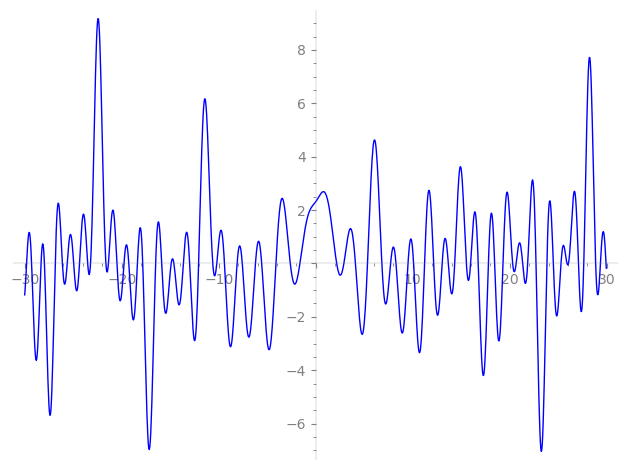| L(s) = 1 | + (0.119 + 0.207i)2-s + (1.71 − 0.272i)3-s + (0.971 − 1.68i)4-s + 1.18·5-s + (0.260 + 0.321i)6-s + 0.942·8-s + (2.85 − 0.931i)9-s + (0.141 + 0.244i)10-s − 3.70·11-s + (1.20 − 3.14i)12-s + (−0.5 − 0.866i)13-s + (2.02 − 0.321i)15-s + (−1.83 − 3.16i)16-s + (3.47 + 6.01i)17-s + (0.533 + 0.479i)18-s + (−0.971 + 1.68i)19-s + ⋯ |
| L(s) = 1 | + (0.0845 + 0.146i)2-s + (0.987 − 0.157i)3-s + (0.485 − 0.841i)4-s + 0.528·5-s + (0.106 + 0.131i)6-s + 0.333·8-s + (0.950 − 0.310i)9-s + (0.0446 + 0.0774i)10-s − 1.11·11-s + (0.347 − 0.907i)12-s + (−0.138 − 0.240i)13-s + (0.522 − 0.0830i)15-s + (−0.457 − 0.792i)16-s + (0.841 + 1.45i)17-s + (0.125 + 0.112i)18-s + (−0.222 + 0.385i)19-s + ⋯ |
\[\begin{aligned}\Lambda(s)=\mathstrut & 441 ^{s/2} \, \Gamma_{\C}(s) \, L(s)\cr =\mathstrut & (0.873 + 0.487i)\, \overline{\Lambda}(2-s) \end{aligned}\]
\[\begin{aligned}\Lambda(s)=\mathstrut & 441 ^{s/2} \, \Gamma_{\C}(s+1/2) \, L(s)\cr =\mathstrut & (0.873 + 0.487i)\, \overline{\Lambda}(1-s) \end{aligned}\]
Particular Values
| \(L(1)\) |
\(\approx\) |
\(2.23545 - 0.581892i\) |
| \(L(\frac12)\) |
\(\approx\) |
\(2.23545 - 0.581892i\) |
| \(L(\frac{3}{2})\) |
|
not available |
| \(L(1)\) |
|
not available |
\(L(s) = \displaystyle \prod_{p} F_p(p^{-s})^{-1} \)
| $p$ | $F_p(T)$ |
|---|
| bad | 3 | \( 1 + (-1.71 + 0.272i)T \) |
| 7 | \( 1 \) |
| good | 2 | \( 1 + (-0.119 - 0.207i)T + (-1 + 1.73i)T^{2} \) |
| 5 | \( 1 - 1.18T + 5T^{2} \) |
| 11 | \( 1 + 3.70T + 11T^{2} \) |
| 13 | \( 1 + (0.5 + 0.866i)T + (-6.5 + 11.2i)T^{2} \) |
| 17 | \( 1 + (-3.47 - 6.01i)T + (-8.5 + 14.7i)T^{2} \) |
| 19 | \( 1 + (0.971 - 1.68i)T + (-9.5 - 16.4i)T^{2} \) |
| 23 | \( 1 + 5.60T + 23T^{2} \) |
| 29 | \( 1 + (0.119 - 0.207i)T + (-14.5 - 25.1i)T^{2} \) |
| 31 | \( 1 + (0.830 - 1.43i)T + (-15.5 - 26.8i)T^{2} \) |
| 37 | \( 1 + (-4.77 + 8.26i)T + (-18.5 - 32.0i)T^{2} \) |
| 41 | \( 1 + (-5.09 - 8.81i)T + (-20.5 + 35.5i)T^{2} \) |
| 43 | \( 1 + (1.11 - 1.92i)T + (-21.5 - 37.2i)T^{2} \) |
| 47 | \( 1 + (2.91 + 5.04i)T + (-23.5 + 40.7i)T^{2} \) |
| 53 | \( 1 + (-5.80 - 10.0i)T + (-26.5 + 45.8i)T^{2} \) |
| 59 | \( 1 + (1.30 - 2.25i)T + (-29.5 - 51.0i)T^{2} \) |
| 61 | \( 1 + (-3.80 - 6.58i)T + (-30.5 + 52.8i)T^{2} \) |
| 67 | \( 1 + (1.75 - 3.03i)T + (-33.5 - 58.0i)T^{2} \) |
| 71 | \( 1 - 8.60T + 71T^{2} \) |
| 73 | \( 1 + (7.57 + 13.1i)T + (-36.5 + 63.2i)T^{2} \) |
| 79 | \( 1 + (3.68 + 6.38i)T + (-39.5 + 68.4i)T^{2} \) |
| 83 | \( 1 + (-3.47 + 6.01i)T + (-41.5 - 71.8i)T^{2} \) |
| 89 | \( 1 + (1.37 - 2.37i)T + (-44.5 - 77.0i)T^{2} \) |
| 97 | \( 1 + (3.58 - 6.20i)T + (-48.5 - 84.0i)T^{2} \) |
| show more | |
| show less | |
\(L(s) = \displaystyle\prod_p \ \prod_{j=1}^{2} (1 - \alpha_{j,p}\, p^{-s})^{-1}\)
Imaginary part of the first few zeros on the critical line
−10.61223019526996754047899565839, −10.19817157704785087693120749228, −9.406072908948473834257274910423, −8.103405766153312586192027076795, −7.57045855627139334355605988479, −6.21377668916765105320636046516, −5.56962810906274523851419656299, −4.10073594017250321008704666569, −2.62301239629133119775779063264, −1.62998602028642733219654517237,
2.15880911901928764762469436026, 2.90252439774174758763314600069, 4.09406272915861283726589052920, 5.33608891328725984526118772991, 6.81834782256230203733435564747, 7.71662633276882773905175972623, 8.274381043234263801983211197546, 9.511823867792781822509567723673, 10.09004293007223472001561322608, 11.21951843364043184747286680776

